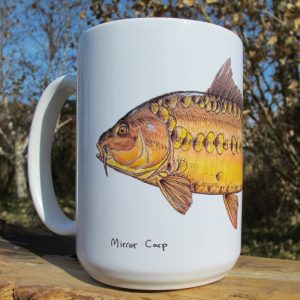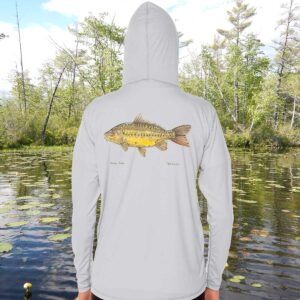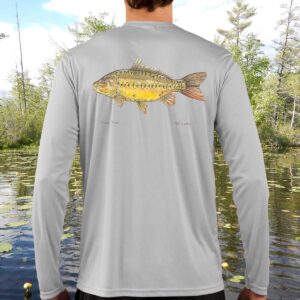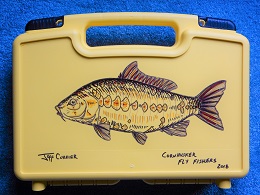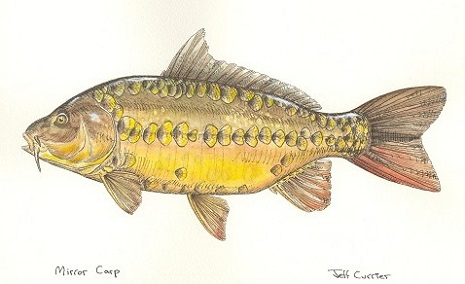 (Cyprinus carpio carpio)
(Cyprinus carpio carpio)
by Jeff Currier
Description
Though a devoted trout angler may disagree, the mirror carp is one of the most handsome of all freshwater fish. Mirrors are stout, thick bodied fish with large and uniquely gold scaled sides. Every scale is a different size. Usually, the scales are arranged in linear fashion, with two rows on top of the back, one down the lateral line of each side, and a row along the belly, all separated by golden brown skin. Some mirrors however, have completely haphazard scale designs and on rare occasions some are fully scaled. No matter how many mirrors you catch, no two will be the same, but all will be beautiful.
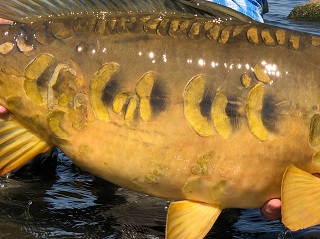 The mirror carp is a mutation of the common carp and is so different in appearance that one might incorrectly assume that it is a separate species. But it’s not. Mirrors are actually descended from common carp bred by monks back in the 12th century to have few or no scales, making them easier to prepare for eating.
The mirror carp is a mutation of the common carp and is so different in appearance that one might incorrectly assume that it is a separate species. But it’s not. Mirrors are actually descended from common carp bred by monks back in the 12th century to have few or no scales, making them easier to prepare for eating.
Size
Mirror carp can grow in excess of 50lbs. While mirrors of this size are uncommon there are places in Great Britain where such fish are well known and been named. In the US these unique fish do obtain huge sizes. In many western lakes and reservoirs the chance at casting to a mirror over 30lbs is a daily occurrence. Any mirror carp taken on a fly rod 20lbs or more is considered a true accomplishment.
My Largest So Far
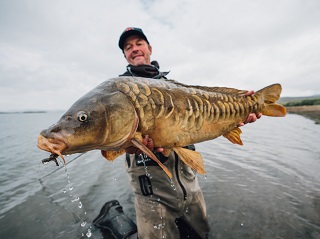
Photo by Winston Fly Rods
During my 30 year stint in Idaho I lived close to Blackfoot Reservoir which is in my opinion one of the top places to fly fish for mirror carp. I caught numerous huge mirrors, many of them 25lbs or more. I rarely weighed the true giants because I didn’t have a scale big enough! Once a year however, we had the Johnny Boyd Carp Classic, where a group of 75 carp fly anglers got together for a two day fund raising tournament. Every fish was weighed on a certified scale. Most registered fish were over 20lbs and every tournament had a 30-35lb fish. I developed a good eye for the size of these fish. The one I’m posing with here is likely in the 30lb plus range.
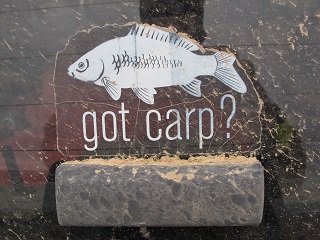 Distribution
Distribution
Mirror carp are native to Asia and Europe and can also be found in Africa, South America and Australia. These nonnatives are widely distributed throughout North America. Any place you find common carp you may also find mirror carp. They are particularly prolific throughout the Rocky Mountain West. Mirror carp were common in my waters in and around the lower reaches of the Snake River in Idaho.
Habits
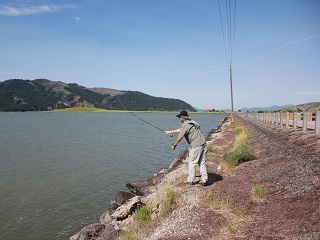 Mirror carp are cool water fish that can tolerate a wide range of water conditions and temperature ranges. They thrive in clean water rivers, lakes and reservoirs yet happily survive in not so clean and even polluted inner city canals and ponds. They prefer the shallows and are usually found in or close to weeds where the majority of their diet is found.
Mirror carp are cool water fish that can tolerate a wide range of water conditions and temperature ranges. They thrive in clean water rivers, lakes and reservoirs yet happily survive in not so clean and even polluted inner city canals and ponds. They prefer the shallows and are usually found in or close to weeds where the majority of their diet is found.
One of the major successes of mirror carp is their ability to feed on a variety of things. They usually have their noses down searching for plant life, aquatic insects, crayfish, or minnows. I witnessed a hefty 25” mirror devour a school of baby bluegill sunfish on the edge of a rock dike. The school started with about a dozen two inch bluegills and over a 30 minute period the mirror plucked them away one by one. Had I not seen this with my own two eyes I wouldn’t have believed it!
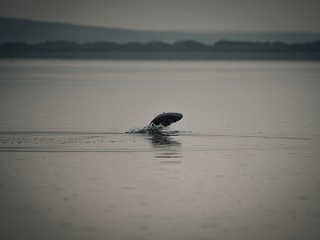
Photo by Winston Fly Rods
Mirror carp are active during the entire open water season. In the spring after ice out they are seen in huge schools often leaping in the air. This is part of the spawning routine and there are many theories about these leaps. While most say the carp are leaping to break loose egg sacks I think it’s a territorial leap. Lakes are often silent then one fish jumps. Next thing you know several jump in response.
The mirrors are hard to catch early season because like most spawning fish they have more important things to concentrate on. As the season warms along with the water temperatures, the mirrors get more active and hunt often. In Idaho our best times to chase them on the flats were the heat of July and August.
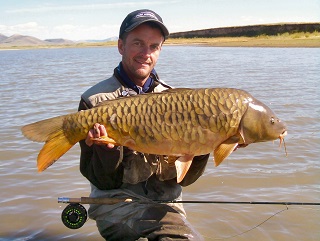
Personal Experience
My mirror carp love started by accident in about 1995. I went through a fishing phase of searching for huge trout on lakes in early spring after ice out. The interest led me two hours from my Victor, Idaho home to Blackfoot Reservoir where I found large rainbows and cutthroats. On every trip I saw the mirror carp but didn’t pay them much attention. Then one day while stripping a sculpin streamer along a weed bed I hooked up only the fight was superior to any trout I’d ever battled. I suspected right away my first mirror was on the other end of the line.
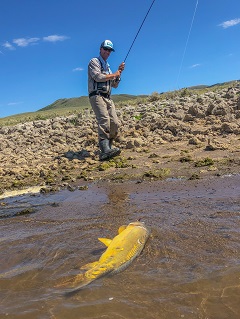 Honestly, due to my trout set up of a 5-weight rod and 3X tippet I thought the fish would win. But after my first good look at this remarkably decorated fish with huge gold scales and a heap of attitude, I had to land it. It took me nearly 15 minutes to get him tired and then he wouldn’t fit in my net. After some careful maneuvering I beached the carp. He was easily 18lbs or more. At the time I didn’t have an eye for such weight.
Honestly, due to my trout set up of a 5-weight rod and 3X tippet I thought the fish would win. But after my first good look at this remarkably decorated fish with huge gold scales and a heap of attitude, I had to land it. It took me nearly 15 minutes to get him tired and then he wouldn’t fit in my net. After some careful maneuvering I beached the carp. He was easily 18lbs or more. At the time I didn’t have an eye for such weight.
From that day on I had a new fly fishing focus – mirror carp on fly. And of course, because I caught that one by accident, I thought these contestants were easy. Not so much! It took me several trips if not more to get my next. Fortunately I found other nearby lakes as well that had smaller more forgiving mirror carp to play with. After nearly 30 years of pursuing these intelligent and wary fish, I can catch them most places and rarely get blanked on my home carp waters!
Tactics
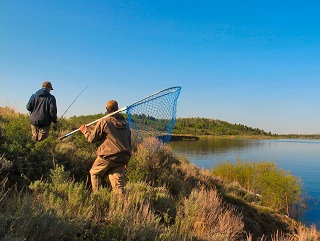 The best way to approach any carp is by sight casting so the first thing you need to do is find the mirror carp. Walk slowly and look for a muddy area created by feeding mirrors, a protruding tail or cruisers. Don’t bother casting to free-jumpers. Its good to see this behavior because you know the carp are around, but chances are they aren’t leaping for food.
The best way to approach any carp is by sight casting so the first thing you need to do is find the mirror carp. Walk slowly and look for a muddy area created by feeding mirrors, a protruding tail or cruisers. Don’t bother casting to free-jumpers. Its good to see this behavior because you know the carp are around, but chances are they aren’t leaping for food.
Most often, you’ll find mirrors in or around a murky muddy area. These fish feed most heavily along the bottom over silt and sandy locations with weeds. They usually have their heads down blowing and pushing around with their nose. As they root around, they kick up debris from the bottom. This debris often forms a cloudy or muddy spot in otherwise clear water called a “mud”. This is always a feeding carp.
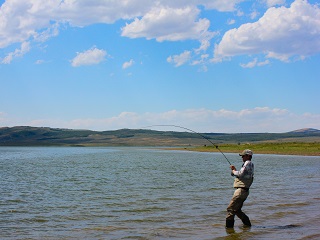 Watch the mud to determine which direction the feeding mirrors are traveling. Muddy areas will lighten and clear up after the carp passes through. No sense in casting behind them. Where you see fresh puffs of new mud forming is where the carp actually are. Place your cast slightly ahead of the mud. Let the fly settle and slowly strip. If you feel tension or a strike – strip set. Do not set the hook by raising your rod. If the fish isn’t there continue to strip. When you hook up, then you can raise your rod and prepare for battle!
Watch the mud to determine which direction the feeding mirrors are traveling. Muddy areas will lighten and clear up after the carp passes through. No sense in casting behind them. Where you see fresh puffs of new mud forming is where the carp actually are. Place your cast slightly ahead of the mud. Let the fly settle and slowly strip. If you feel tension or a strike – strip set. Do not set the hook by raising your rod. If the fish isn’t there continue to strip. When you hook up, then you can raise your rod and prepare for battle!
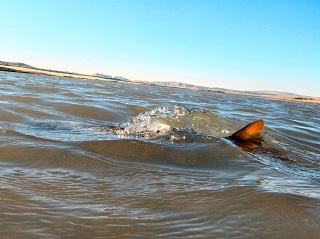
Tailing mirror carp are the most exciting to try for. A tailing mirror is one with its nose to the bottom in water shallower than the length of its body. Because of this, when tipped down the tail actually sticks out of the water. This is a carp engrossed in feeding and has let its guard down. This is one of the best opportunities to get a hookup. Despite this advantage you must make a good cast. Try to drop the fly three inches in front of the fish. To the mirror, your fly will look like a disoriented prey trying to get back to the bottom to hide after being stirred up. Hold your rod low and get tight to the fly. Be prepared for an aggressive grab on the first strip!
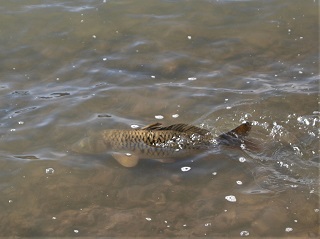 Cruising mirror carp, the most difficult to catch, like to move about in pairs. Sometimes they travel quickly and seldom stop to eat a fly. Other times they push themselves along for a couple of feet, stop to detect any food on the bottom, and then repeat the process. Although their barbells are doing the detective work, mirrors have respectable eyesight and are always looking a foot or so ahead for any fleeing prey.
Cruising mirror carp, the most difficult to catch, like to move about in pairs. Sometimes they travel quickly and seldom stop to eat a fly. Other times they push themselves along for a couple of feet, stop to detect any food on the bottom, and then repeat the process. Although their barbells are doing the detective work, mirrors have respectable eyesight and are always looking a foot or so ahead for any fleeing prey.
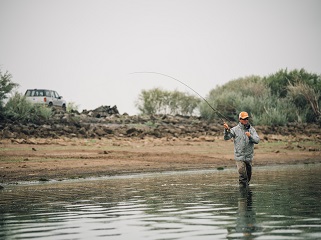
Photo by Winston Fly Rods
Drop your cast about two feet in front of the lead fish. This allows the fly to get down near the bottom to meet the fish head on. When the mirror gets within about six inches, give the fly a short strip. If the fish makes a sharp turn away from where the fly landed, gently pick up the cast and try again. If you have the right fly, there’s a good chance you will watch him eat it!
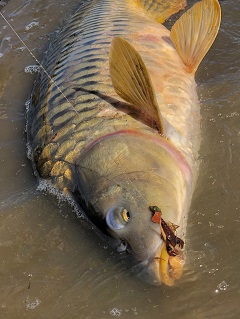
Mirrors do at times feed on the surface. Usually these are under calm conditions and often the hottest days of summer. Mirrors love various seeds, berries and insects so imitations of these can work well. I personally like using dry flies for trout such as Chernobyl Ants, beetles, hoppers and mayflies.
The mouth of a mirror is not made for feeding off the surface so it’s an awkward move for them. Sometimes they push the fly away when they try to eat it. There’s no sense in setting the hook until its in their mouth. Watch carefully for it to disappear first. Dry fly fishing for carp takes skill and patience but can be very rewarding.
Equipment
Rod: 9-foot for a 6-weight line.
A 6-weight sounds light for a potentially 20lb fish, but heavier lines crash to the water hard and spook these cagey creatures ending your chances of a hook up in the first place. I learned by trying an 8-weight for a year. Once hooked, you will definitely have your hands full. Take your time and don’t worry about fighting them too long. Its hard to hurt a mirror carp!
Reel: A reel with a smooth drag and capacity for 75 yds of backing is essential.
Line: 6-weight, weight forward floating, WF6F.
Leader: 9 to 12-foot for 14 to 20-pound tippet.
Flies: The best hook sizes are from 4 to 14. Most mirror carp fishing is done subsurface with flies on or close to the bottom. I prefer flies where the hook points ride up. Small brown Clouser minnows work excellent most of the time, however if the fish are especially spooky sometimes the plunk of a Clouser can scare them. I also like bonefish flies such as the Crazy Charlies or Bonefish Bitters in colors tan, root beer or chartreuse. Crayfish patterns can be superb. Also nymphs such as Stoneflies, Beadhead Rubber-leg Hare’s Ear, Red Copper John, Damsels and Prince. The best dry flies are seed and berry imitations, Chernobyl Ants, hoppers, beetles, ants and mayfly patterns.
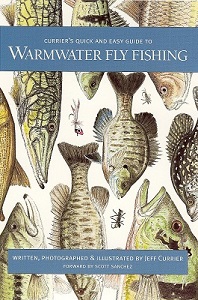 Learn More
Learn More
Learn more about fly fishing for warmwater game fish by ordering an autographed copy of Jeff’s book, “Currier’s Quick and Easy Guide to Warmwater Fly Fishing”. Jeff’s popular book includes not only more strategies for carp, but also tactics and flies for smallmouth bass, pike, perch, walleye and more!
Jeff’s Mirror Carp Art
Get Jeff’s Mirror Carp artwork on a variety of products by visiting his growing web store. Order one of his famous 15 oz coffee mugs, a frosted beer stein, a sun shirt or hoodie or Jeff’s custom sharpie art on a Cliff Fly Box. You can even commission Jeff to paint the one you caught!

 Distribution
Distribution
